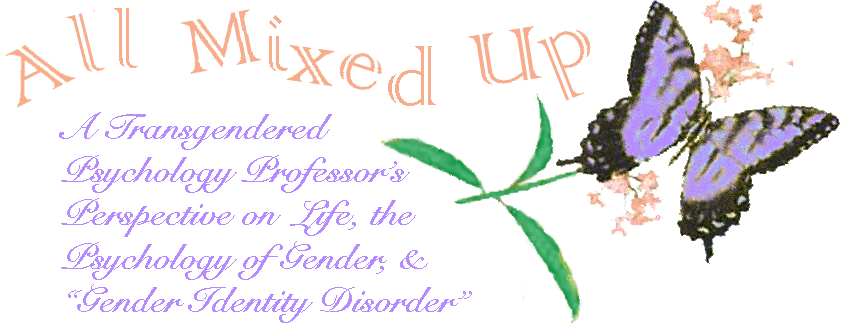
|
|

|
Blanchard's model categorizes transsexuals into two types based on sexual orientation: "homosexual" (those attracted to their biological sex) and "non-homosexual." A mis-directed sex drive causes transsexuality. The mis-directed sex-drive among "non-homosexual" trassexuals is called "autogynephilia."
This is page 3 of 13. [1] [2] [3] [4] [5] [6] [7] [8] [9] [10] [11] [12] [13]
Ray Blanchard's theory of transsexuality and transgenderism has two basic parts. There are categories of gender incongruence and a causality that underlies how we become transsexuals. The two categories of people are based on our sexual orientation. One group is exclusively attracted to their biological sex. They are male-to-female transsexuals who are attracted to men and female-to-male transsexuals who are attracted to women. The second category of transsexuality includes everyone else. For example, this category includes male-to-female transsexuals who are attracted to women, bisexual, or those without strong sexual attractions to men or women.
The same basic mechanism underlies the development of transsexuality in each group: a mis-directed sex-drive. In particular, those transsexuals attracted exclusively to their biological sex have a mis-directed homosexual sex-drive while the other group of transsexuals has a mis-directed heterosexual sex-drive. Those attracted to their biological sex become enamored with attracting their biological sex. For example, a female-to-male attracted to women is driven by his attraction to women to become a man. Those transsexuals not attracted to their biological sex become enamored with being their target sex. For example, a male-to-female transsexual attracted to women is driven by her attraction to women to be a woman herself. To use a fancy word, this latter group is described as having "autogynephilia."
Underlying Blanchard's choice of words, like "mis-directed sex drive", are the assumptions that typical heterosexuality and typical homosexuality are legitimate targets for a sex-drive. Not everyone agrees. The conservative Christian movement believes that the one thing a sex-drive should be for is heterosexuality. Others like me hold a scientific value-neutral belief about sexuality. Sex-drives are not for anything, that simply do something. Though I feel Blanchard makes a mistake by incorporating his value-judgements into his theory, we can still consider his theory scientific even if his words are not always as neutral as they might be.
Blanchard's theory has many more corollaries. For example, in addition to an atypical sex-drive, he believes that transsexuals also have a typical heterosexual or homosexual sex-drive with which the atypical sex-drive competes. Another corollary concerns a variation on autogynephilic fantasies found in bisexual transsexuals: fantasies about attracting one's biological sex. He addresses these corollaries and others in four empirical works. For sake on succinctness, I will not critique any of these corollaries in the present discussion. Instead I focus on the evidence for his two key ideas.
There are four empirical works published in peer-reviewed academic journals that provide evidence for aspects of Blanchard's Model. These articles are only authored by Ray Blanchard. All of the empirical evidence supporting the two key ideas in Blanchard's theory is published in a single empirical paper (Blanchard, 1989): "The Concept of Autogynephilia and the Typology of Male Gender Dysphoria" published in "The Journal of Nervous and Mental Disease" (v.177(10), pp.616-623). This paper did not address female-to-male transsexuality. He also did not study the sexual desires associated with a transsexual's attraction to their biological sex. Despite the limitation in sample and mis-directed sex-drives measured, Blanchard found his expected results. Male-to-female (MtF) transsexuals attracted to men were less likely to have sexual fantasies about being a women than other MtF transsexuals. One corollary Blanchard addressed in this paper was also supported. Bisexual MtF transsexuals were more likely to have sexual fantasies about being a woman with a man than other MtF transsexuals.
This is page 3 of 13. [1] [2] [3] [4] [5] [6] [7] [8] [9] [10] [11] [12] [13]
|
|
|